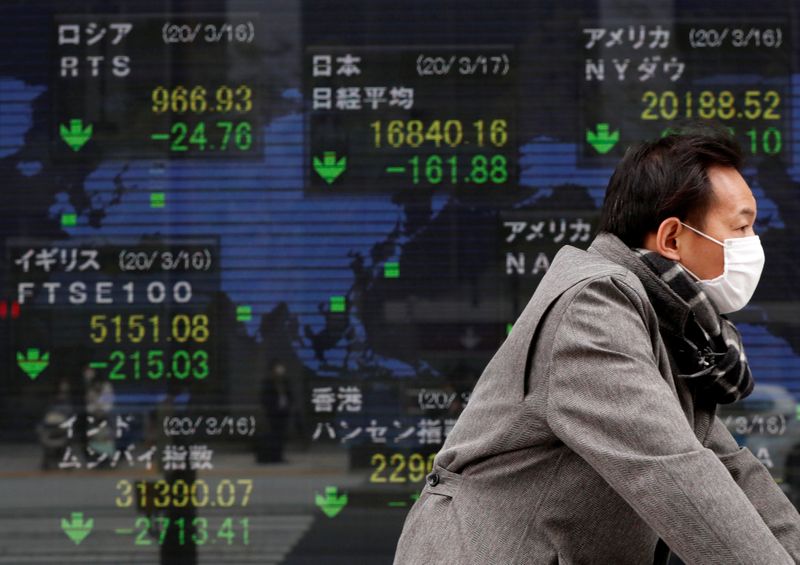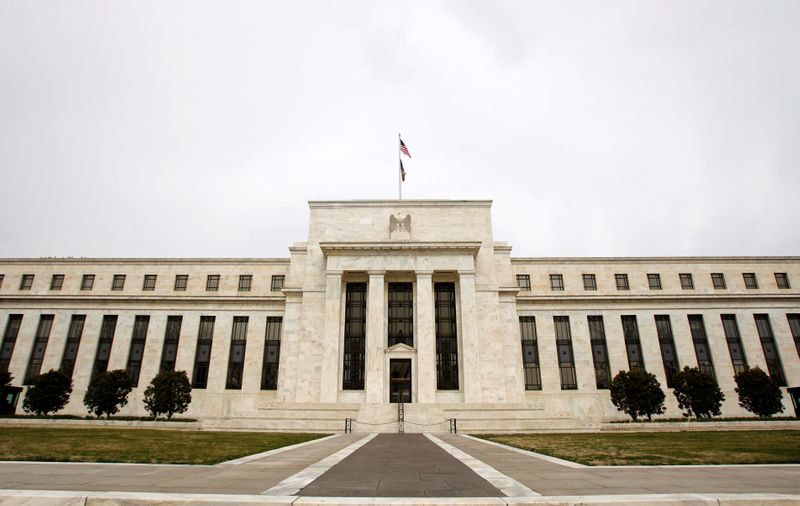
FILE PHOTO – A man wearing a protective face mask following an outbreak of the coronavirus disease (COVID-19) walks past a screen displaying the world’s markets indices outside a brokerage in Tokyo, Japan, March 17, 2020. REUTERS/Issei Kato
April 15, 2020
By Koh Gui Qing
NEW YORK (Reuters) – Asian shares looked set to pull back from a one-month high on Tuesday, as warnings of a deep recession dampened investor optimism that the slowing spread of the coronavirus could allow businesses to re-open.
E-Mini futures for the S&P 500 <ESc1> fell right from the closing bell and were down 0.26%, while Nikkei futures <NKc1> pointed to an opening loss of around five points, defying broad gains in U.S. stocks overnight.
The retreat from riskier assets followed the International Monetary Fund’s prediction on Tuesday that the global economy may shrink by 3% in 2020 due to the virus outbreak, in the worst downturn since the Great Depression of the 1930s.
Even estimates for a partial recovery next year are marred by “extreme uncertainty” and the outcome could be far worse, depending on the course of the pandemic, the fund warned.
Some analysts agreed and counselled caution.
“The current market optimism may be premature because the global economy is in a deep recession,” said Kim Mundy, an analyst at Commonwealth Bank of Australia.
“We expect the global economy will contract by 2.8% in 2020, vastly more than during the great financial crisis.”
Asian stocks <.MIAPJ0000PUS> had climbed to their highest in a month on Monday, buoyed by Chinese trade data that showed exports did not slow as much as feared in March, even though analysts warned the outlook for the world’s second-largest economy remained grim.
In energy markets, concerns about a global recession led crude oil prices to plunge by over 10% towards $20 a barrel overnight, as investors doubted a record global output cut could offset a sharp drop in demand as the economy stalls.
By 2300 GMT, U.S. crude futures <CLc1> had recovered a touch and were up 3.1% at $20.74 a barrel, but a long way from a January high of $63.27.
Healthy demand for less risky investments and a softer dollar kept gold prices near a 7-1/2-year peak. Spot gold prices <XAU=> were flat at $1,728.44 an ounce, after hitting a high of $1,738.05 earlier, a level not seen since late 2012.
Still, some investors took heart from news the coronavirus outbreak may be near a peak as European countries such as Austria and Spain started to loosen lockdown restrictions.
In the United States, which has suffered the most fatalities from the virus, the governors of seven states, including New York, said they were preparing plans to gradually restart the economy.
Sparks of investor optimism, alongside the U.S. Federal Reserve’s massive new lending programme to support the economy, pinned the U.S. dollar — another traditional safe-haven asset — at a two-week low.
Against a basket of six currencies, the U.S. dollar index <USD=> eased 0.5% to 98.86. That helped the euro <EUR=> cling to earlier gains at $1.0984, while the greenback stayed soft against the Japanese yen <JPY=> at 107.17.
U.S. 10-year yields <US10YT=RR> were little changed at 0.750% as investors braced for Wednesday’s release of March U.S. retail sales data, which will give a key gauge on how the virus pandemic has hurt the U.S. economy.
In a sign of the pandemic’s toll on the economy, two major U.S. banks — JPMorgan Chase & Co <JPM.N> and Wells Fargo & Co <WFC.N> — reported plunges in first-quarter profit on Tuesday as both set aside billions of dollars to cover potential loan losses.
James Bullard, the president of St. Louis Federal Reserve, estimated on Tuesday that the economic shutdown due to the coronavirus pandemic is costing the United States perhaps $25 billion a day in lost output and cannot be sustained indefinitely. But to re-open, he said the country needs risk management strategies and widespread testing.
(Reporting by Koh Gui Qing; Editing by Sam Holmes)

